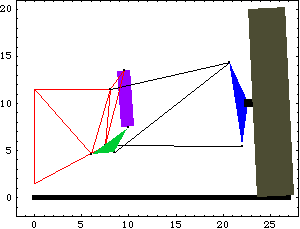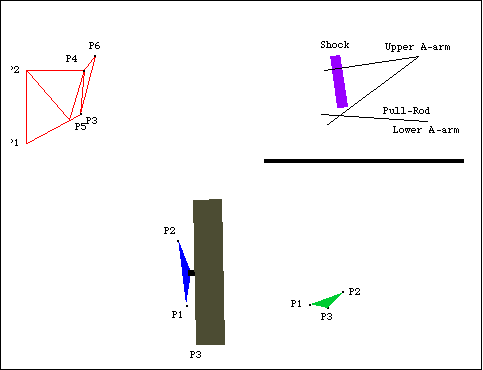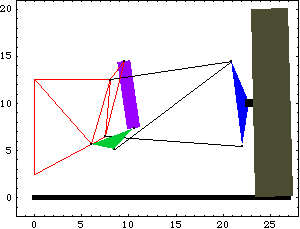4.1.1 2D Example MechanismTo demonstrate the use of the Mech velocity and acceleration solutions, a 2D model is developed that can be measured. A 3D model is treated in the same manner as 2D with regard to higher-order solutions. The model is be a pull-rod and rocker rear suspension linkage for a car, consisting of three moving bodies: the chassis, the carrier, and the rocker. A real suspension linkage would have three more moving bodies: the upper and lower A-arms, and the pull-rod between the wheel carrier and the rocker.
The input to the model is the chassis moving vertically relative to the ground. This model could have been reduced in size by making the ground body the chassis, and simply moving the wheel carrier relative to the chassis, but the chosen method allows more flexibility and makes for better graphics.
The wheel carrier is attached to the chassis by two A-arms. These A-arms are not modeled as independent bodies because their function can be represented by a pair of relative distance constraints between the chassis and the wheel carrier.
The rocker pivots about an axis on the chassis and is attached to the wheel carrier by the pull-rod, a connecting link in tension. This pull-rod is also modeled with a relative distance constraint, not a separate body.
The shock absorber is connected between the other end of the rocker and the chassis. The damper is not actually part of the kinematic model at all, but the length of the damper as a function of wheel motion is a primary point of interest for any suspension linkage. Thus, the shock absorber exists only as a pair of mounting points on the chassis and the rocker, the separation of which can be measured as the car is bounced. Here is a graphic of the 2D pull-rod suspension model.

BodiesFour body objects are defined for the pull-rod suspension model. The ground body (body 1) requires two point definitions.
P1 is the origin of the ground body.
P2 is a point directly above the origin that defines a vertical translation line upon which the chassis slides.The chassis (body 2) requires six local point definitions.
P1 is the local origin, which is a point at the bottom of the chassis.
P2 is a second point that, with P1, defines the vertical translation line of the chassis.
P3 is the pivot point of the lower A-arm.
P4 is the pivot point of the upper A-arm.
P5 is the pivot point of the rocker.
P6 is the upper mounting point of the shock absorber.The wheel carrier (body 3) requires three local point definitions.
P1 is the local origin, which is the attachment point of the lower A-arm.
P2 is the attachment point of the upper A-arm and the pull-rod.
P3 is the bottom of the tire where the tire contacts the road.The rocker arm (body 4) requires three local point definitions.
P1 is the local origin, which is the rotational axis of the rocker.
P2 is the lower attachment point of the shock absorber.
P3 is the attachment point of the connecting rod.Here are each of the bodies in the pull-rod model.

This loads the Modeler2D package and defines names for each of the bodies in the model. Here are the four body objects for the pull-rod model. The body objects must be incorporated into the current model with SetBodies. ConstraintsSeven constraints, one of which is a driving constraint with explicit dependence on time, are used to model the pull-rod suspension. A RelativeY1 constraint, used as a driving constraint, controls the vertical position of the chassis. This constraint is a driving constraint because it is functionally dependent on the time variable T.A Translate2 prismatic constraint controls the chassis rotation and horizontal position and allows the chassis to move only vertically relative to the ground.A RelativeDistance1 constraint models the upper A-arm.A RelativeDistance1 constraint models the lower A-arm.A RelativeY1 constraint forces the bottom of the tire to remain in contact with the ground.A Revolute2 constraint places the axis of the rocker arm.A RelativeDistance1 constraint models the pull-rod. The length of the pull-rod is specified by rodlength, which must be given a numerical value before Modeler2D attempts to find a solution.Here are the seven constraint objects for the pull-rod model. The constraint objects must be incorporated into the current model with SetConstraints. Note that the explicit symbol that is used to represent time in Modeler2D (T by default) may be changed. The SymbolBasis option for SetSymbols is a nested list of strings that determines the basis for all of the Global` symbols created by Modeler2D. Redefining the first element of SymbolBasis changes the symbol that is recognized as the time variable. SymbolBasis is the basis for all Modeler2D global symbols.
Out[20]= |  |
RuntimeBefore the model can be run, the symbol rodlength, which determines the length of the pull-rod, must be defined. Because of the presence of T in the driving constraint (constraint 1), the model can be run through its intended range of motion by varying T directly with the first argument to the SolveMech command. The way that this model is defined, the numerical value of T specifies the distance between the chassis and the ground. The symbol rodlength must be defined. Now the model is run at T = 2.5.
Out[22]= |  |
Here is the pull-rod suspension model at T = 2.5.

|